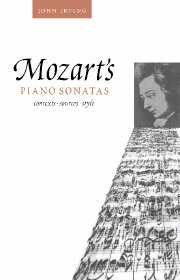Book contents
11 - Dispositio: rhetoric and design
Published online by Cambridge University Press: 15 December 2009
Summary
DISPOSITIO (ARRANGEMENT, DESIGN)
The traditional division of the rhetorical dispositio was into the six categories of exordium (introduction), narratio (statement of facts), propositio (proposition), confirmatio (proof), refutatio (refutation) and peroratio (conclusion), categories which were applied to the arrangement of a ‘musical oration’ (Klang-Rede) by Mattheson and later copied by Forkel, as noted in chapter 9. Before proceeding to a detailed interpretation of Mozart's sonatas according to such an approach, it is important to warn against too literal an application of rhetoric (most especially, perhaps, of the parts of the arrangement, developed in rhetoric primarily for legal prosecution and defence). This was conceded by Mattheson himself, following a review of Kern melodischer Wissenschaft in Lorenz Mizler's Neu-eröffnete musikalische Bibliothek, in which it was claimed that Mattheson had confused exordium, narratio and propositio by applying each of these terms to the same melody. Mattheson's response incidentally shows that he equated the outline of a musical ‘form’ with the conduct of ‘melody’:
Marcello [the composer of the aria which Mattheson had quoted as a demonstration of rhetoric in music] … has given as little thought to the six parts of an oration in composing the aria I published in the Kern, as in his other works; but one concedes that I have quite plausibly shown how they must be present in the melody [my italics] … Experienced masters proceed in an orderly manner, even when they do not think about it … it would be very pedantic indeed if one were to look for all these elements in their particular order in every melody [my italics] and seek to apply them … […]
- Type
- Chapter
- Information
- Mozart's Piano SonatasContexts, Sources, Style, pp. 116 - 150Publisher: Cambridge University PressPrint publication year: 1997

